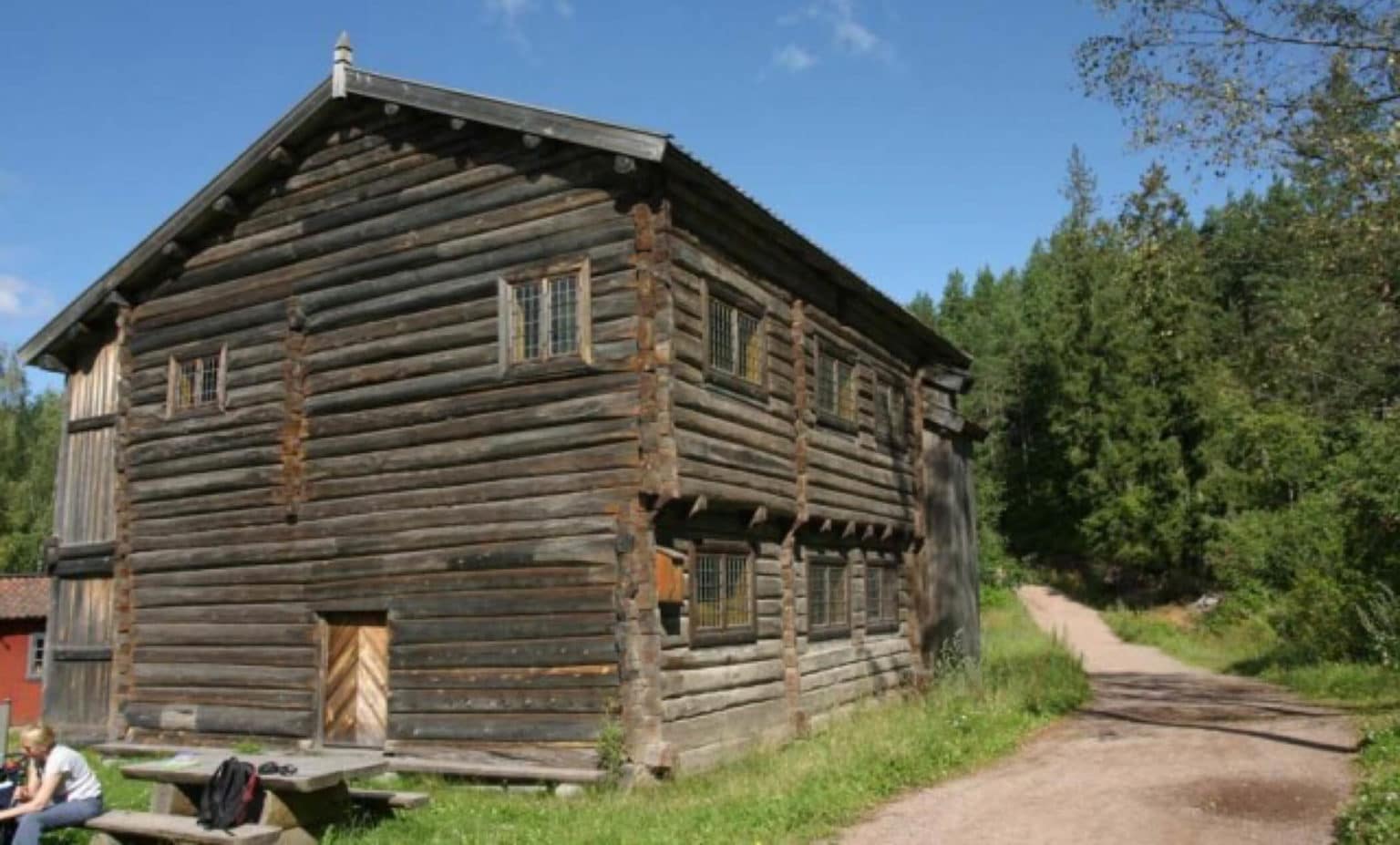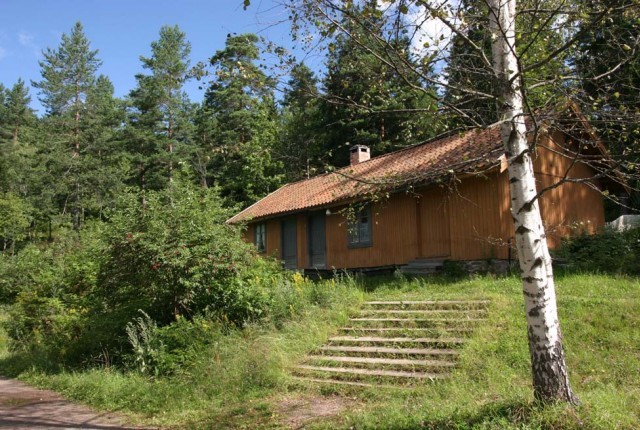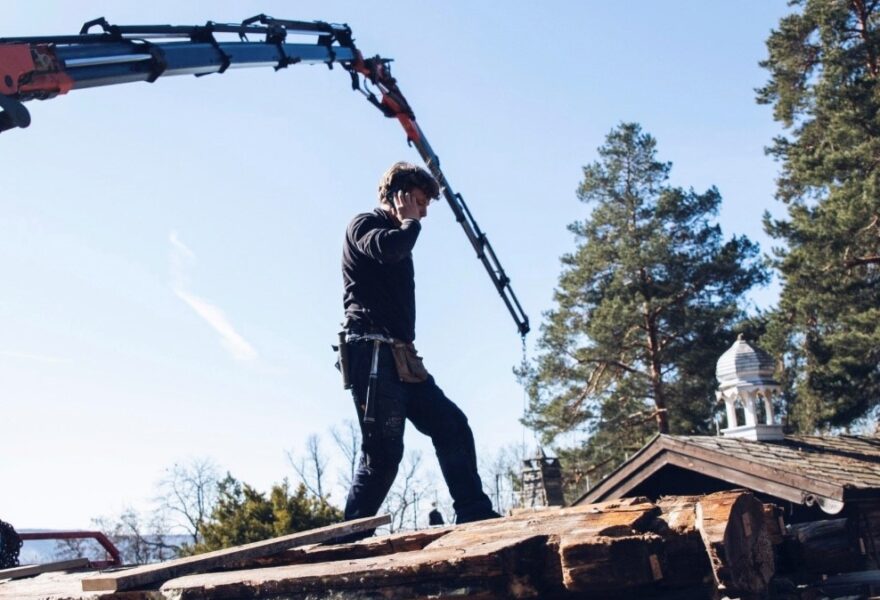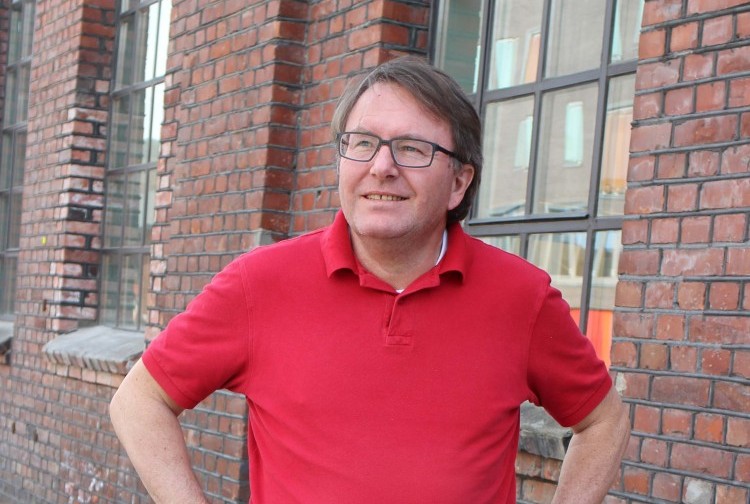Open air museum, Bragernesåsen
In the middle of the city's hiking terrain 300 meters within Spiraltoppen, 21 old log houses have now been rebuilt to illustrate past farms and building traditions in Buskerud.
In 1914, Drammens Museum took over a timbered farmhouse from Moldbakken in Torpo in Hallingdal. The farmhouse had been at the Anniversary Exhibition at Frogner (Kristiania) and the museum had lent the inventory. Now the museum took over the house and rebuilt it in the park at Marienlyst. Drammens Museum had budding ambitions to build an open-air museum inspired on the Norwegian Folk Museum with the idea of showing the peasant culture in Buskerud from the time before industrialization. Several old log houses from Hallingdal followed: a storehouse from Tunehagen in Ål was built in 1917, a stable from Søre Villand in Hol was rebuilt in 1922, an attic from Mellom Rue in Hol was rebuilt in 1927. Then followed a sauna from Rud in Hovet which came up in 1937. The museum bought these houses but the war then put an end to the project, which involved building an open-air yard on a plot all the way to Danvikgata.
After the war, the ambitions grew. During the war years, the museum had secured several relevant houses and wanted a larger area than the plot at Marienlyst. In 1949, the municipality of Drammen handed over to the museum a 530-acre area in Kobbervik's forest under Nordbykollen on Tangen. Eventually, 20 houses were rebuilt here, but it proved difficult to operate properly. Two houses were set on fire. When the municipality wanted the area for housing development, the museum was allowed to dispose of a 200-acre area on Bragernesåsen, within the "Spiral". In 1967 it was decided to move the museum. The houses in Kobbervikskogen were demolished and stored. However, the plans dragged on, and it was not until 1987 that the first houses were rebuilt. Between 1987 and 2000, 20 houses were rebuilt. 9 of the houses had stood in Kobbervikskogen.
Havnegata 52, Drammen
The building from Havnegata on Tangen in Drammen dates from the early 1800s and was originally located with the front facing the sea and the back facing the street. Between 1886 and 1925, the house was a caretaker's home for Tangen public school. There was a charity public school at Tangen as early as 1752. Children of parents who could pay went to civic schools, while charity schools were reserved for children of poor families and orphans. The building has been donated to the museum by Drammen Slip & Verksted.
Skustad landhandel
Landhandel from Ner-Skustad, Øverskogen in Lier, probably built as a country store in the first half of the 19th century. The trading business seized two of the rooms in the building. The third room - on the left - was used as a storage room in the winter and the farm's brewery in the summer. The building came to Drammen's museum in 1976 with the original interior. Here, the museum tries to recreate some of the old atmosphere in a country store with goods both on the shelves and on the ceiling.
Vikebygningen
The building was moved from the Sundstreplassen Østre Vikersund in 1990. The guest house was built in 1665 by Lieutenant Johan Sommer and expanded to both sides in the 1690s. These parts were later demolished so that only the oldest part remains. Johan Sommer was demobilized after the peace in Copenhagen in 1660 and, like many other officers, was given the right to run an guesthouse.
The building differs from the peasant society's building practice in the 17th century and it is close to large buildings like manors and large townhouses in Christiania and Drammen at the same time: The window openings are large and the beams have profiled projections. Only the timber core was preserved, and the hallway has been reconstructed according to traces in the building.
Toenstua
Mønsåsstua from Toen in Svene, Flesberg in Numedal is dated to 1711. The farmhouse has a living room and a hut. Originally the door was straight to a vestibule, but was later moved, probably at the same time as the living room got a new rose-painted interior. In 1792, the furniture was decorated in rose-painting, probably by Thore Kravik.
Setra
Langedragsetra from Nore in Numedal was built according to local tradition in 1730 with an earthen floor, open fireplace - hearth - in the middle of the floor, lyre in the ceiling and wall-mounted beds and benches. Seterbua has three rooms: "guard watch", the saddle room and the milk shed. In the milking parlour there are shelves for storing milk and milk products, therefore it is located at the north end of the house to keep milk, cheese and butter as cool as possible. In the front swallow there is a band attachment for cattle on the wall.
Åmotseterfjøset
Barn from heimesetra under Sør-Skjønne, Nore in Numedal. Heimestera was used first in the spring and last in the autumn, while the cows were on the mountains in the summer. The barn is very large and could hold over 20 cows, but the stalls are small and cramped even for the small cows that existed at the time. The barn door faced a river, where there was a notch. There was also a ditch that led to the river. They could save a lot of water carrying by filling the water to the cow right in this ditch. The barn was in use until the museum bought it in 1949.
Basolstua
This small cabin was the workshop of the rose painter Per Basol from Eggedal. He was born in 1887 and lived and worked here from 1928 to 1971. His homestead is now at Sigdal museum, while his workshop has been placed here in Drammen. Per Basol made a living as a rose painter. He painted what people wanted - both locally and for the tourists. His painting style follows the traditional style from around 1850, and he used clear and clean colors when he was selling things in Eggedal, and - as he said - more soft colors when he was selling to tourists. Next to the rose painting shed, a small barn building from Bingen is stored.
Village case from Gunhildsrud on Øvre Eiker
This is a village saw with two saw frames, ie it could cut two logs at the same time. Saws that were powered by hydropower existed in this country as early as the 16th century. Previously, tables were made either by splitting a log or by sawing by hand. Most of the sawmills were built by the waterfalls at Modum and by Vestfossen. At first, it was the nobles or the church who owned the sawmills, but eventually the townspeople in Drammen gained control of the sawmills in the watercourse. The upswing saws led to a sharp increase in production. A sawmill with a sawmill worker could cut up to three dozen tables a day. From 1688, the saws received quotas for how much they could cut, and were called quantity saws. The farmers were only allowed to cut tables for their own use. This saw from Gunhildsrud was a flood saw that only had water for operation in spring and autumn. It was built in 1809 - around that time the authorities began to abolish all regulations on sawmill operations. This saga is a gift to the museum from Drammens Handelsstands forening.
Mill house
This mill house comes from the farm Holo in Hallingdal. It was used to grind grain and salt. The last time it was used was when grinding salt around 1910. The whaterwheel sits under the house and drives the millstone around, when there was enough water. Many brook grinders had enough water only during the flood in spring and autumn. Not all farms had grinders, so some had to have their grain ground by a neighbor. Grain grinding was the man's job - except out of season when they had to fall back on the old hand grinder, which was the women's job.
Workshop
This farmhouse comes from the farm Nedre Vinna in Krødsherad. The house was protected, but the owner wanted to use the plot for other purposes, and so it ended up at Drammens Museum. The farmhouse has remnants of rose paint on the interior. Some are dated to 1783 and some to 1855. On a cupboard door we can read: "Painted by me GTS Foss". On the door to the chamber we find a representation of David and Goliath, and on the lower door mirror is painted a mermaid. Recently, the farmhouse was used as a summer cabin.
Loft from Ål and cage from Garnås in Nes
Attic and granary side by side, as they stand on Hallingtunet at Friluftsmuseet, was a common sight in the valleys in Buskerud. They had different functions. The granary or storehouse, was a construction to store food. Flatbread, flour, salt meat, etc. were stored here. They were built in stave work so that it would be difficult for mice to enter. The attic was used for storage of clothes, chests and other valuables. There were also wall-mounted beds on the second floor that were used as a guest loft. The bride and groom spent the night in the attic, and in the summer the girls slept on the farm there. The courtship night is often associated with a visit to the girls in the attic. The attic from Strand in Ål is of the medieval type and is considered to be from the beginning of the 18th century.
Øvrejordefjøset
This barn comes from the farm Øvrejorde in Hol in Hallingdal. It was probably built in the 1820s - 30s. It is a large barn of 60 m2 and has 12 stalls and 4 detached rooms. Three of the stalls are larger than the others and are perhaps intended for steers? This barn has windows, which became common around 1850, so they could be added later. Windows in the barn were just of this type: three or four panes in a row. At the bottom of the barn there is a loft or barn shed, and here was space for servants to rest. The old living rooms were small, so servants often had to sleep in the barn. It was nice and warm there because of the cows, but of course they also smelled. It was too hot for the sheep and goats inside the barn, so they got their own barn without windows.
The cell cabins
After the liberation in 1945, the Home Forces handed over several cell cabins to Drammen's museum. The museum moved them to Kobbervikskogen, but here a couple of them burned down after people had broken into them. The museum has rebuilt three of the cabins on Bragernesåsen. There is also a hatchery called "Valhall" and a small sauna from Holtefjell and a log cabin from Kistefoss in Snarum.
Klokkergaarden - Culture and Nature Kindergarten
Klokkergaarden Kultur og Naturbarnehage (kindergarten) is located at Friluftsmuseet and consists of three houses, Klokkergården, Havnegata and Naturhuset.
Address:
Slettåsen 16, 3014 Drammen
See also...
The barn from Straumen has now been completely restored
The barn from Straumen in Norway has been completely restored with several extensive and necessary improvements. Traditional craftsmen Audun Eken, Eivind Vinger and Thomas Løken have restored the log building which is now secured for the future.
Kjell Nilsen - leader of Friluftsmuseet's friends
Kjell Nilsen is the leader of Drammens Museum's new Friends Association Friluftsmuseet Venner and was in his time to start both Gulskogen's farm friends and Austad farm friends. I have a commitment to both culture and sports and my heart beats for Drammen, he says eagerly before the start of the season for the new friends association.







